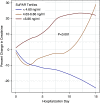Soluble Urokinase Receptor (SuPAR) in COVID-19-Related AKI
- PMID: 32963090
- PMCID: PMC7608953
- DOI: 10.1681/ASN.2020060829
Soluble Urokinase Receptor (SuPAR) in COVID-19-Related AKI
Abstract
Background: AKI commonly occurs in patients with coronavirus disease 2019 (COVID-19). Its pathogenesis is poorly understood. The urokinase receptor system is a key regulator of the intersection between inflammation, immunity, and coagulation, and soluble urokinase plasminogen activator receptor (suPAR) has been identified as an immunologic risk factor for AKI. Whether suPAR is associated with COVID-19-related AKI is unknown.
Methods: In a multinational observational study of adult patients hospitalized for COVID-19, we measured suPAR levels in plasma samples from 352 adult patients that had been collected within 48 hours of admission. We examined the association between suPAR levels and incident in-hospital AKI.
Results: Of the 352 patients (57.4% were male, 13.9% were black, and mean age was 61 years), 91 (25.9%) developed AKI during their hospitalization, of whom 25 (27.4%) required dialysis. The median suPAR level was 5.61 ng/ml. AKI incidence rose with increasing suPAR tertiles, from a 6.0% incidence in patients with suPAR <4.60 ng/ml (first tertile) to a 45.8% incidence of AKI in patients with suPAR levels >6.86 ng/ml (third tertile). None of the patients with suPAR <4.60 ng/ml required dialysis during their hospitalization. In multivariable analysis, the highest suPAR tertile was associated with a 9.15-fold increase in the odds of AKI (95% confidence interval [95% CI], 3.64 to 22.93) and a 22.86-fold increase in the odds of requiring dialysis (95% CI, 2.77 to 188.75). The association was independent of inflammatory markers and persisted across subgroups.
Conclusions: Admission suPAR levels in patients hospitalized for COVID-19 are predictive of in-hospital AKI and the need for dialysis. SuPAR may be a key component of the pathophysiology of AKI in COVID-19.
Keywords: AKI; COVID-19; CRP; SARS-CoV-2; SuPAR; acute renal failure; coronavirus; dialysis; renal replacement therapy; urokinase.
Copyright © 2020 by the American Society of Nephrology.
Figures






References
Publication types
MeSH terms
Substances
Grants and funding
LinkOut - more resources
Full Text Sources
Other Literature Sources
Medical
Research Materials
Miscellaneous

